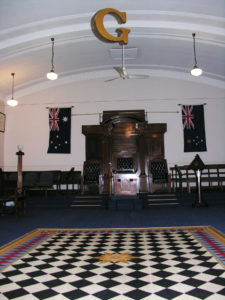The Yarrowee Freemasonic Lodge of Ballarat East met for the first time on 22 April 1857. Present at the first meeting were Richard O’Cock, a solicitor whose tent was opposite George and Martha Clendinning’s on the Ballarat goldfields in 1853, Alexander Dimant, a member of the Jewish faith, James Stewart, a doctor, J. Daly, Bernard Smith, T. Cope, Robert Walsh, a solicitor, Walter Lindsay Richardson, (a doctor associated with Henry Cuthbert, the solicitor), Robert Holmes, (who was Martha Clendinning’s brother), R. Fenton, and W. Robinson. Members of the Yarrowee Lodge, many of whom were also Anglo-Irish, moved quickly into philanthropy, establishing a Board of Benevolence and a Board of General Purposes with contributions paid into the funds from initiation fees, joining fees and from each member’s annual subscription.
As citizens of some standing, many had been involved in the establishment of the municipalities of Ballarat and Ballarat East, 75% of the men being members of local councils, with some using such positions, later, as a springboard to parliamentary office. During the period of Ballarat’s early urban development however, few took this step. Between 1851 and 1870, a total of 29 politicians were elected to either the Legislative Council or Assembly from Ballarat, but only four of these sat on the committee of a major charity in which there was a high degree of common membership. Freemasons dominated all Ballarat’s charitable committees, creating powerful alliances, and thus the rapid development of charity in Ballarat was made possible by existing networks and bonds amongst these influential men of the town’s two municipalities.
The major underlying factor that linked the Ballarat philanthropists to each other and to the broader community was the fraternity of Freemasons. The influence of Freemasonry in Ballarat extended beyond the individual lodges, with Freemasons dominating all of the early charitable committees. Freemasons may have been active in other urban centres, using philanthropy as a means to elevate social status, promoting the ideas of benevolence, and maintaining the fraternity. The study of the correlation between Freemasonry, philanthropy and power therefore deserves further historical investigation.
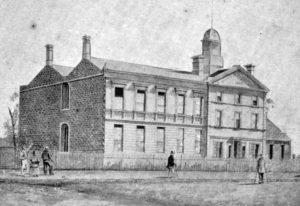
Miners’ Hospital on the corner of Drummond and Sturt Streets, Ballarat.
The first in the series of major charities to be established in Ballarat was the Ballarat Miners’ Hospital. Early attempts by Gold Commissioner Robert Rede to arouse interest amongst the miners to build a public hospital had failed, so it was the businessmen of Ballarat who took the lead. Rede had applied for a building grant from the colonial government who had promised the sum of ₤1000, but this was conditional on an equivalent amount being raised by public subscription which did not eventuate until July 1855 when a new secretary, Mr Jabez Ham, brother of parliamentary figure David Ham, was appointed.
A serious fund-raising campaign was undertaken. Within one month the money had been raised and the plans for the new hospital were commissioned. Ballarat hospital historian, Anthea Hyslop observes, that the miners then began to display a ‘decided disposition to support benevolent projects … and pledged energetic support, showering the platform with small gold nuggets’. By December 1855 the Foot Police had been granted the building at the Government Camp in Lydiard Street that had formerly been used as a hospital so that the first charity committee was able to argue convincingly that there was a desperate need for a new hospital to cater for the sick in Ballarat.
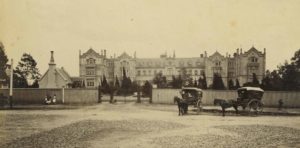
Ballarat Benevolent Asylum, now operating as the Queen Elizabeth Centre: Ballarat Health Services, Ascot Street, Ballarat
The next charity to be established in Ballarat was the Ballarat Benevolent and Visiting Society in 1857. It offered outdoor relief to the destitute and was the precursor to the Ballarat Benevolent Asylum. The need for outdoor relief had been brought to public attention by the case of Mrs George Wright whose husband, a newly arrived immigrant, unemployed and poverty-stricken, committed suicide on 26 November 1857. She was left with two small children and because there was no form of organised charity in Ballarat the most attractive option open to her was a public appeal. The new society set out to relieve the sick and aged poor in their own homes, and was prepared to assist ‘other deserving Applicants upon the Report of the Visitors appointed to inquire into the merits of each case’.
The Ballarat Benevolent Asylum evolved from the Ballarat Visiting and Benevolent Society. Community support for the Benevolent Asylum in 1859 was evident, with Ballarat and Ballarat East Councils each donating ₤200, supplementing the grant of ₤2000 for building, and ₤500 for maintenance made by the Legislative Assembly with ₤1000 to be raised by subscription. The Ladies’ Fancy Bazaar held during Easter week in the Council Chambers provided ₤572. The proprietors of the Theatre Royal and the Chinese Theatre, Hon. George Coppin and Mr Bridges, made donations. The government granted five acres of swampy Crown Land for the institution.
The Ballarat Benevolent Asylum admitted its first patient, James Miller, a 65-year old Scottish miner, on 21 February 1861. The funds of the institution were provided by grants from government, church collections and voluntary contributions. Every donor of ₤10 or more could become an honorary member for life; every donor of ₤5 became an honorary member for three years; every contributor of ₤2 an honorary member for one year and every contributor of sixpence or more for three months could become a member. Although mining was a major cause of many of the injuries that forced people to seek the shelter of the asylum, only four mining companies: The Great Extended, Koh-I-noor, British, Allied Armies and Independent Companies had responded to the early appeal. Donations came primarily from ministers and church congregations, members of Manchester Unity, the Independent Order of Oddfellows, the Ancient Order of Foresters, the Caledonian Society, and prominent individuals. Only when the asylum was established was there increased support from the mining companies, adding their contributions to the funds raised through lectures and entertainments, and continued support from councils.
The Common School established in 1861 by the Benevolent Asylum committee, catered for mainly orphaned children and, by 1863, had over sixty children on its rolls. By the mid 1860s the committee of the Benevolent Asylum was arguing that it was undesirable for orphans, delinquents, the aged, female cases, and the chronically ill to be housed together at one asylum. Suddenly two more institutions, an orphanage and an industrial school, were deemed to be desperately needed in Ballarat.
The Ballarat Orphan Asylum was an initiative of a group of Ballarat publicans, led by Mr W. Redfern, and members of local Friendly Societies. It set out to provide ‘deserted and orphan children … not only with a home in which they could be properly cared and provided for, and attended to, but also where they would be educated and taught such habits of industry, order and forethought as would fit them to become useful members of society’.
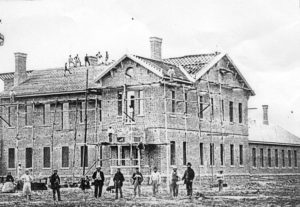
Ballarat Orphanage being built in the 1860s.
William Webster, the secretary of the committee for the proposed Asylum wrote to the government in 1866 asking for finical assistance. He indicated that the committee had already expended ₤2835.14.5 on the building, the whole of which had been obtained without government assistance. The building was almost ready for occupation and the committee was seeking the usual grant for the building and its maintenance. The Ballarat Orphan Asylum opened on 8 July 1866. Those considered too ‘superior’ for state care were accommodated at the orphanage.
In 1868 most of the children from the Ballarat Benevolent Asylum Common School were sent to the new state industrial school, the orphanage, or as apprentices and domestic servants.
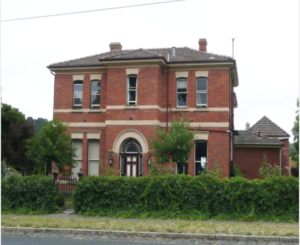
Ballarat Female Refuge, 183 Scott Parade, Ballarat East. This building was adjacent to the Alexandra Toddlers’ Home.
For ‘young women who have been led astray’ the town developed another institution, the last in its chain of charities: the Ballarat Female Refuge. The need for a female refuge had initially been raised in the Police Court hearings, on 27 April 1867, (over a case of drunkenness) and in July women interested in the establishment of a female refuge n Ballarat were invited to meet in the lecture room at the Mechanics’ Institute. A small number of ladies assembled for the preliminary discussion, a subscription list was opened and contributions were immediately sought. The ladies followed the pattern already established by their male predecessors. A government grant was requested and with the ₤150 obtained they purchased a house in Grant Street, Ballarat East. This cost ₤160 with a further ₤33 being ‘expended upon necessary fencing’ but at this time, it was noted, ‘no furniture, or fittings of any kind’ had been received. An advertisement was placed in the Ballarat Star requesting the services of a matron for ₤60 per annum. Six candidates applied and Mrs White from the Ballarat Benevolent Asylum was duly appointed and the committee declared the work ready to begin.
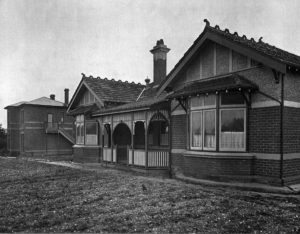
Alexandra Toddlers’ Home, with the Ballarat Female Refuge. A few babies were accommodated at the Refuge, but when they were old enough they lived at the Alexandra Home. At the age of about 3-4 years they were then sent to the Ballarat Orphan Asylum.
The Refuge was different from the other charitable organizations for it had a female committee. Where elite men were expected to engage in public philanthropy, for women aspiring to elite status, such a prominent engagement with the public world was a far more contested practice. The way in which the ladies of Ballarat used the Refuge to establish their right to engage in the public sphere is another chapter in the history and evolution of charity in Ballarat.
Clearly, philanthropy was the preserve of those who exercised power at the local level. Those men who sat on the committees had the time and means to participate in the business of establishing and managing charities, while the contacts they made through conducting their businesses ensured that they never sat amongst strangers. Their rising status gave them the motivation and invested in them the moral authority to establish charitable institutions.
The members of the various charity committees were overwhelmingly Protestant, which reflected the percentages in the general population. Protestants comprised approximately 81.07% of the population in Ballarat in 1854 and 82.2% in 1857 contributing 86.21% of members of Ballarat’s charitable committees up until 1870.
Although the percentage of Protestants in Ballarat’s philanthropic committees was similar to that in the general community, the analysis of Protestant denominations within Ballarat’s philanthropic committees shows that the men who pursued philanthropic activities were mainly Methodists and Anglicans.
Anglicans thus dominated Ballarat’s charitable committees. Shurlee Swain has argued, and rightly so, that across the colony Anglicans were ‘over-represented amongst those who administered charitable organisations of the colony and under-represented amongst those who had the need to call upon their services’. In Ballarat it was the congregations of the evangelical Church of England congregations of St Peter’s and St Paul’s which replicated this pattern.
The over-representation of Methodists is more significant. Methodism had grown rapidly in the colony because it was able to meet the needs of the highly mobile gold rush population. For many of its adherents it provided a route to social mobility through its emphasis on thrift, abstinence and self-help. For such men, Weston Bate argues, ‘it was a badge of success to be on the hospital, benevolent asylum or orphanage committees’.
Despite their denominational differences, Anglicans and Methodists shared an adherence to Evangelical Christianity and its moral crusade aimed at transforming and converting individuals by promoting temperance, maintaining the Sabbath, and upholding moral standards. Having experienced personal salvation, they recognised a responsibility to help others to achieve a similar goal.
Catholics however represented only 3.45% of charity committee members in Ballarat, although being around 15% of the general population. The majority of Ballarat’s Catholics were Irish, a product of the mass migration that followed the famine. They were to be found clustering in the poorest areas of Ballarat East, Eureka and Bakery Hill. The efforts of the few members of this impoverished community who did become wealthy were focussed on building the church, leaving little time for involvement in the town’s major charities. The were not members of the business and political networks from which such committees recruited.
By contrast, the Jews, who made up a mere 0.78% of the population of Ballarat represented a significant 10.35% of the charity committees. The Jewish community had a strong tradition of philanthropy and was quick to set up both the Ballarat Jewish Philanthropic Society and the Ballarat Hebrew Ladies’ Benevolent Society in the town. In order to be acknowledged as worthwhile, honorable, and valuable citizens in their new homeland they sought and accepted positions on the major community charitable committees as well. The multiple relationships that they enjoyed with members of the dominant Protestant Evangelical elite indicates an acceptance which the Catholics were denied.
Hence it was not a shared religious or ethnic affiliation that defined that subsection of Ballarat’s elite that dominated its principal charities. The major organisation that brought together both Jews and Protestants, but which was generally not open to Catholics, was Freemasonry. A sample of committee members of Ballarat’s charities that have been studied for this article, comprised 61.36% Freemasons, while only 4.5% were not Freemasons, leaving 34.09% whose status is unclear.
Freemasonry was evident throughout the memberships of Ballarat’s charities, and in the ceremonies associated with them. On 28 December 1855 the foundation stone of the Miners’ Hospital was laid with Masonic honors at the site on the corner of Sturt and Drummond Streets. Prominent at the ceremony were the hospital’s newly elected trustees, Messers Elliott, Oddie, Ranken, Dixie and Foster, and doctors Hillas, Clendinning, and Stewart, all of whom were Freemasons.
Mr Michael Cummins who took in the Wright family and encouraged the formation of the Ballarat Benevolent and Visiting Society was a prominent Freemason, so that, although the Cornish community was credited with raising the initial funds for the Wright family, in the establishment of the Ballarat Benevolent and Visiting Society, on 30 November 1857, Freemasons played a major role. Mr James Oddie presided over a twenty-eight member committee which included fellow Freemasons Mr A. A. Tarte, as Hon. Secretary, and Mr A. S, Park as Hon. Treasurer. Robert Lewis, a member of the Masonic fraternity, who later became President, audited the accounts with J. M. Strongman for the half-year ending 31 December 1858.
Ballarat’s Freemasons laid the foundation stone of the Ballarat Benevolent Asylum. The Right Worshipful Brother, Francis Thomas Gell, formed a Grand Freemasonic Lodge in Ballarat and, immediately after its formation, at 11 am on 17 March 1859 the Prov. Grand Master, Grand Officers and all brethren ‘formed a procession, and, clothed in full regalia, carrying banners and working tools’, marched from St Paul’s church in Ballarat East to lay the foundation stone, of the proposed Ballarat Benevolent Asylum with due ritual and ceremony. The Ballarat Benevolent Asylum was almost six kilometers distant, the procession passing through the middle of the city. This procession and the laying of the foundation stones of various other charities and notable establishments in Ballarat by the Freemasons was a public display of the status of this fraternity reinforcing the position of the Freemasons in the community as major contributors to the community’s philanthropic institutions.
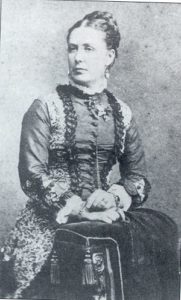 The first teacher of the Benevolent Asylum’s common school, Mrs Matilda Dixie, was the widow of the Freemason Joseph Dixie, a friend of fellow Freemason, James Oddie who had recommended her for the job. Mr Henry Cuthbert, a barrister and prominent Freemason, prepared indentures and other legal work for many of the charities in Ballarat. Jabez Ham, who instigated the first Miners’ Hospital and his brother David Ham, were both prominent Freemasons. Henry Caselli and Samuel Figgis, architects, who designed many of Ballarat’s institutions, with Charles Davenport Cuthbert, architect, were also Freemasons.
The first teacher of the Benevolent Asylum’s common school, Mrs Matilda Dixie, was the widow of the Freemason Joseph Dixie, a friend of fellow Freemason, James Oddie who had recommended her for the job. Mr Henry Cuthbert, a barrister and prominent Freemason, prepared indentures and other legal work for many of the charities in Ballarat. Jabez Ham, who instigated the first Miners’ Hospital and his brother David Ham, were both prominent Freemasons. Henry Caselli and Samuel Figgis, architects, who designed many of Ballarat’s institutions, with Charles Davenport Cuthbert, architect, were also Freemasons.
The publicans who comprised the first committee of the Ballarat Orphan Asylum, Robert W. Watson, E. Steinfeld, R. B. Gibbs, W. Scott, R. Kent, James Gougon, Charles Dyte, A. Anderson, C. D. Cuthbert, Gilbert Duncan, D. R. Morris, were all Freemasons, along with W. Dunn, J. Draddock, R. Jones, R. U. Nicholls, W. L. Mullen, William Webster, H. H. Peake, G. Lovitt, William Jones, Thomas Potter, E. J. Rosenblum, and W. P. Martin whose status is unclear.
The ladies that comprised the committee of the Ballarat Female Refuge, such as Martha Clendinning, were wives and sisters of Freemasons, and many, like Matilda Dixie, looked to the Masonic elite for support. Messers Salmon, Oddie and Sim were appointed trustees.
The land and house acquired for the Refuge on 10 September 1867, allotment 22 of section 98 Ballarat East, was previously owned by William Young of Wesley Methodist congregation. When this property was sold on 14 January 1886 it passed to James Russell, another Freemason. James Oddie purchased the new site, allotment 19 of section 17 in Dyte’s Parade, on 13 May 1884. By 1909 the Ballarat Female Refuge had expanded to include allotments 15, 16, and 17 in the newly renamed Scott’s Parade, all of which had been originally purchased by Freemasons: James Oddie (13/5/1884), Charles Dyte (12/7/1867) and W. B. Rodier (12/9/1864). The foundation stone of the new purpose-built female refuge was laid in 1884 with full Masonic ceremony. Mesdames W. Clark, Jones, Ferguson, Swift, and Binks represented the ladies committee at the laying of the stone. The symbolic tools of the Freemasons were presented at the ceremony by the prominent Freemasons, Mr Figgis, Councillor Roff, Councillor Ellsworth, Mr R. Young and Councillor Ferguson. The building had been designed by the architect of the orphanage, Henry Caselli, and the refuge could also call upon the honorary services of solicitor Henry Cuthbert and doctors Hillas, Clendinning and Stewart, all of whom were Freemasons.
At Freemasonic meetings ideas and concepts were exchanged and discussed, with members being urged to practise compassion an benevolence. During this era Freemasonry was widespread throughout England and continental Europe, and was clearly employed by the emerging middle classes as a means of networking and support. As David Harrison has shown, the active participation of Freemasons in Liverpool, in educational and philanthropic pursuits, reflected their democratic, tolerant and benevolent ideals.
